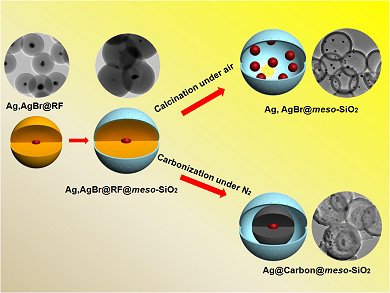Core-shell or yolk-shell structured nanoparticles with controllable size, shape and composition are attracting rapid interest due to their unique functionalities in the cores and shells, making these materials applicable in catalysis, drug delivery, energy conversion and storage. It is highly desirable to develop a simple and general approach to coat crosslinked polymers on nanomaterials to generate core-shell or yolk-shell structured nanoparticles with polymer or carbon shells.
A team, led by Jian Liu, University of Queensland, and Shi Zhang Qiao, University of Adelaide, both Australia, have developed a strategy to synthesize Ag,AgBr@RF core-shell composites from resorcinol–formaldehyde (RF) resin and their derivative core-shell and yolk-shell structured carbon composites (pictured).
The is essentially an improvement and extension of the Stöber route – a process for generation of monodispersed particles of silica – involving emulsion polymerization, which is facile and efficient in crosslinked polymers coating. This method allows for excellent control of the shape and thickness of the shell through simply adjusting the synthesis parameters. This simple one-pot route can be extended to the preparation of core–shell spheres with other metals/metal oxides as cores.
Because of the adjustability and functionality of both cores and shells, these complex core-shell and yolk-shell spheres would have potential applications as nanocatalysts, which has been confirmed by the author’s preliminary photocatalysis study.
- Facile fabrication of core-shell structured Ag@Carbon and mesoporous yolk-shell structured Ag@Carbon@Silica by an extended Stöber method,
Tianyu Yang, Jian Liu, Yao Zheng, Michael Monteiro, Shi Zhang Qiao,
Chem. Eur. J. 2013.
DOI: 10.1002/chem.201300523



